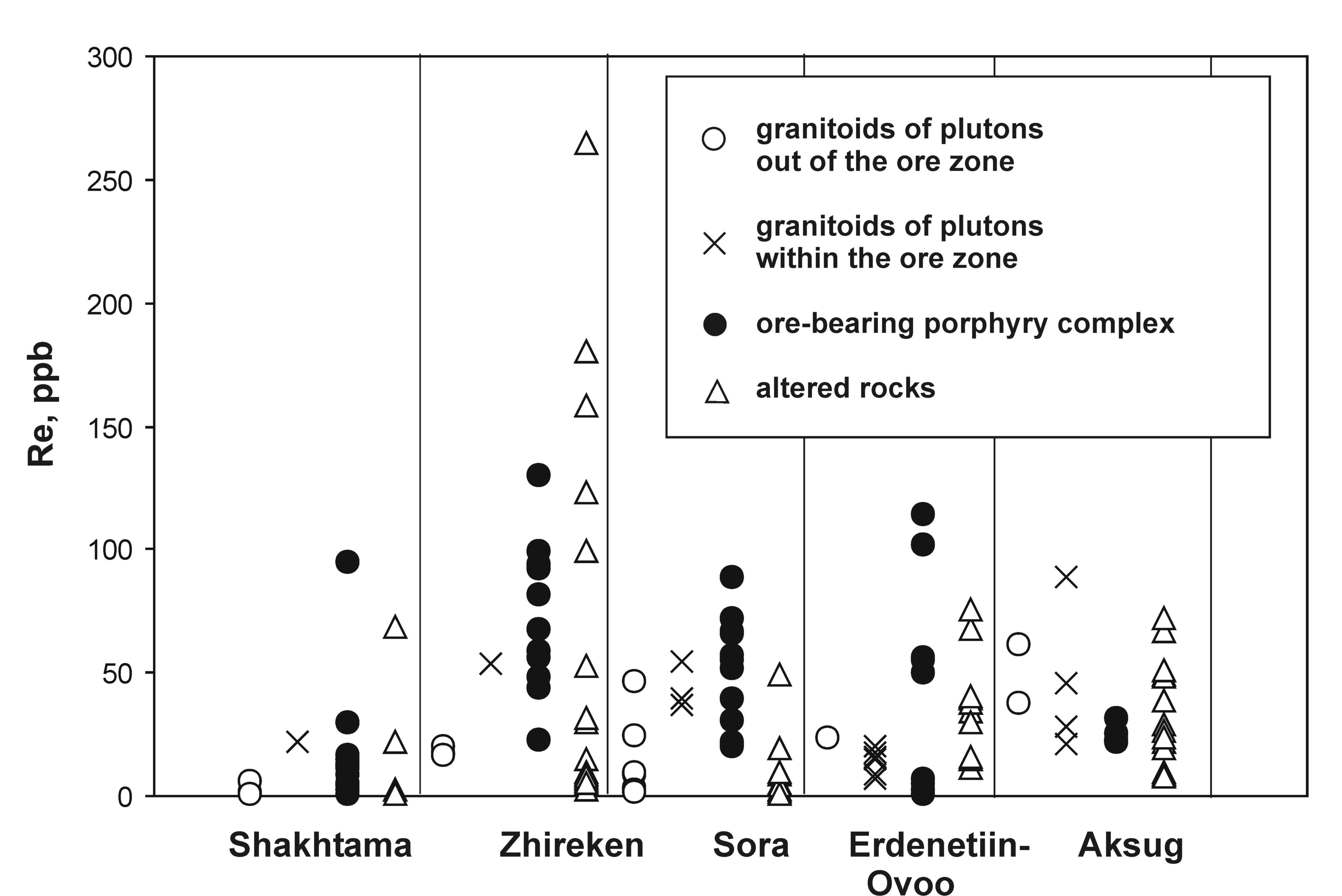|
RHENIUM ABUNDANCES IN MAGMATITES FROM PORPHYRY CU-MO DEPOSITS (SIBERIA, MONGOLIA) Berzina A.N.*, Korobeinikov A.F.** *Institute of Geology and Mineralogy SB RAS, Novosibirsk, Russia, berzina@uiggm.nsc.ru **Tomsk Polytechnical University, Tomsk, Russia, lev@tpu.ru
To investigate the possible causes of rhenium abundance variations, a suite of intrusive rocks from porphyry Cu-Mo deposits of the southern margin of the Siberian Craton have been analyzed for their whole-rock Re contents. The following deposits are discussed: Aksug (northeastern Tuva), Sora (Kuznetsk Alatau), Erdenetuin-Obo (northern Mongolia), Zhireken and Shakhtama (Eastern Transbaikalia). The deposits are localized in the areas, where two multiphase magmatic complexes of different age occur. The early complex is represented by a large granitoid pluton. The later (porphyry ore-bearing) complex is composed by intermediate to felsic porphyritic calc-alkalic or K calc-alkalic multi-phase intrusions. The samples analyzed include: 1) relatively unaltered rocks outside the ore zone, representing the major phases of batholiths that host porphyry intrusions, 2) the same rocks within the ore zone, 3) samples from the least altered and mineralized parts of porphyry systems, and 4) variably altered (potassic, phyllic, argillic alteration) samples of porphyry and plutonic rocks. Most of the samples selected for this study do not contain visible sulphides, and so the impact of mineralization on the whole-rock Re contents should be minimal. Rhenium contents have been measured, using inversion voltametry based on impregnated carbon electrode at the Geological Analytic Centre (Tomsk Polytechnic University, Russia). Detection limit is 1 ppb. Within the group of relatively fresh rocks, the porphyry ore-bearing suite typically shows higher Re content compared to their host plutonic rocks (Fig.1). Rhenium concentration in plutonic rocks decreases outward the ore zone and area of porphyry rocks emplacement. Unaltered rocks of plutons outside the area of porphyry rock emplacement are characterized by relatively regular Re abundances: from 17 to 20 ppb (average 18 ppb) for Zhireken, 1 to 6 ppb (averagely 3 ppb) for Shakhtama, 3 to 46 ppb (averagely 14 ppb) for Sora, 24 ppb (only one sample was analyzed) for Erdenetuin Obo, and 32 to 68 ppb (averagely 50 ppb) for Aksug. Rhenium abundances in altered rocks and magmatites within the ore zone are highly variable, ranging from 6 to 265 ppb at Zhireken, from 1 to 95 ppb at Shakhtama, from 1 to 89 ppb at Sora, from <1 to 114 ppb at Erdenetuin Obo and from 8 to 89 ppb at Aksug. Rhenium contents in major phases of granitoid plutons vary depended on spatial location relative to porphyry stocks and dikes. Rhenium concentration in samples from Uibat granitoid pluton (Sora deposit) is in average 14 ppb, it increases significantly (up to 44 ppb) in the contact zone with porphyry stocks and dikes. Leucogranites of Uibat pluton contain in average 2 ppb Re , while within the area of porphyry dike emplacement, the same leucogranites show higher Re content (up to 24 ppb).
In summary, the alteration shows variable changes in Re relative to fresh rocks. Highly heterogeneous Re distribution magmatites within the area of porphyry rocks location can be explained by hydrothermal metasomatic processes related to the emplacement of porphyry ore-bearing complex. Some significantly altered unmineralized samples show the lower Re contents than fresh rocks. Variable Re contents within highly altered rock samples may be explained by selective remobilization and redistribution of metal during alteration processes. Probably, some portion of Re could be extracted from rocks to metasomatic and ore-bearing solutions during alteration and then redeposited with sulfides. Re abundances in whole-rock samples of the studied deposits are relatively high compared with the earth crust estimate of 1-2 ppb. Elevated Re contents in the samples studied, as well as decreased Re in rocks outward the porphyry ore-bearing stocks and dikes testifies that Re was introduced during porphyry series emplacement and related ore-metasomatic processes. Highly heterogeneous Re distribution in intensely altered rocks testifies to its mobility and redistribution in postmagmatic stage. Significant enrichment in Re of porphyry suite relative to plutonic rocks may be determined by the physical-chemical parameters of the fluids during the emplacement of batholiths and postdating porphyry suite. Significant variations in temperature, pressure, concentrations of fluid components and explosive processes are typical for porphyry systems. Favorable structural conditions (low depth, high fracturing) during porphyry rock emplacement resulted in an increase of the fluid mobility and its concentration. The formation of batholiths took place in relatively closed and stable conditions reflected in more homogenous Re distribution in unaltered rocks of host plutons. This work was supported by RFBR grant 06-05-64254.
|
